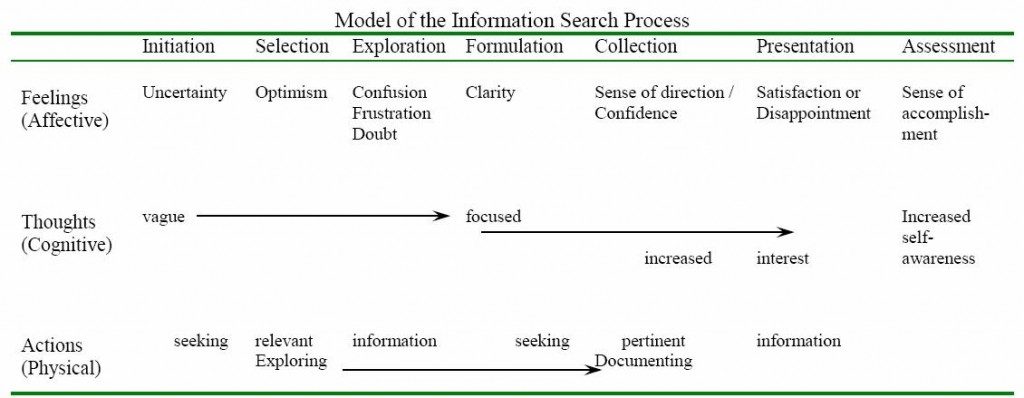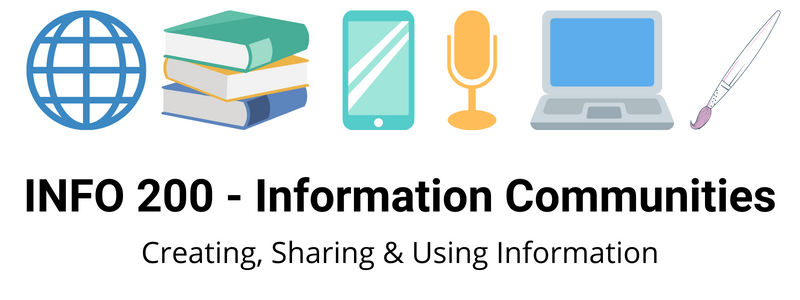As you progress through INFO 200, you’ll be reading a number of theories about information seeking behavior. These readings offer different lenses with which to view and explore your information community. A crucial part of your research paper will be to not only investigate your information community but also apply relevant information behavior theories to frame your findings.
Here is an overview of a selection of key information seeking behavior theories and theorists.
In order to provide their users and populations with relevant information services and collections, information professionals have to be aware of how the people they serve seek information. This behavior has been termed by the information science field as information behavior or information seeking behavior.
Many prominent theories of information seeking behaviors address everyday life information seeking (ELIS) behaviors and describe individual’s actions in models developed to understand the information seeking process. Many of these theorists have taken research methodology from ethnographic and sociological studies and applied them to the observation of information behavior. Understanding ELIS provides insight into peoples’ priorities, information interests, preferences of sources and how they share information in their own ways.
Marcia Bates looked at existing theories of information seeking behavior and developed the Berrypicking information search model which uses the term as a powerful metaphor to highlight that the search process is not static and evolves with time and space. Bates also argues that searchers only gather their information little by little in bits and pieces; all their information needs never collected with one single search but continuously, reformulating or modifying their queries, to “. . . use a wide variety of search techniques which extend beyond those commonly associated with bibliographic databases” (Bates, 1989). The essence of Bates’ theory asserts that when searching for information, users generally do not have a specific search strategy, rather, they berrypick as they find relevant pieces of data.
Nicholas J. Belkin argues that when individuals begin the search for information, they are in an Anomalous State of Knowledge, which describes the mismatch between the information seeker’s knowledge and understanding, and the capability of the system to interpret the question. Belkin believes that the seeker’s cognitive inadequacy affects their state of mind and makes crafting a successful search query into the search system a significant challenge. It is more useful to more fully understand the seeker’s state of mind and knowledge than to jump directly into a search based on that state of mind.
Elfreda A. Chatman focused on ethnographic studies of small world and information outsider populations like the poor, janitors, female members of a retirement community and female inmates. In each of her explorations, she worked to understand the psychological, attitudinal, and cultural reasons these often-isolated populations searched, consumed, accepted or rejected information. She was able to inform the field on how “social norms determined accepted information as opposed to outside information” in her study subjects (Fulton, 2010). She developed her Theory of Life in the Round to explain “the importance of context in shaping an individual’s information seeking” and their “use or nonuse of information” (Fulton, 2010). This theory’s four concepts: small worlds, social norms, social types and worldview, detailed the information worldview of those in small world information communities. Life in the Round and Chatman’s subsequent theories inspired other researchers to continue looking at micro-cultures within the world and their information seeking behavior.
See also: The Impoverished Life-World of Outsiders
Brenda Dervin developed the Sensemaking Theory which is a research methodology, more than a theoretical framework. It refers to a user’s tendency to relate new to existing knowledge. In the context of information seeking, Dervin uses the term verbing to describe the active nature of the search. Information seeking relates to actions more than things (i.e. nouns). Once the knowledge is acquired, a bridge is formed between the new and the previously known concepts. Thus, the sensemaking methodology looks at the context of the situation where users find themselves in need of information due to an information gap and finally how the information is utilized after it is acquired.
Eliza Dresang originally developed the radical change framework from research into youth reading and it is uniquely tailored to the increasingly web-based information seeking community. The core of Dresang’s radical change framework is based on the concepts of interactivity, connectedness and access and Radical Change theory suggests that many of the changes in information resources and human behavior in this digital age can be explained through these core concepts:
- Interactivity: Information can be sought out at any time and in a non-linear process. It is not always the case that a researcher must sit down at a desktop computer and conduct a search, they could be open to finding knowledge at virtually any time.
- Connectedness: Information acquisition can be a social process, whereby the reputation of findings is verified or questioned by others, peers provide information leads, and/or a community of inquiry is established.
- Access: Once acquired, information has the capability to open new doors and provide access to new information or communities. This also speaks to the concept that information can be found in a wide variety of resources and places.
See also: Radical Change Revisited.
Sandra Erdelez is dubious about the term information seeking behavior. She considers the process of acquiring information on more of a continuum. So, perhaps you are searching for a specific data point, and in the process, you find something that was not your primary focus at the moment but is useful. This is more than serendipitous information gathering, it is really a way of thinking and behaving in an information-rich environment. Erdelez posits that information acquisition is not always an active process and the transmission of information often comes organically through accidental encounters of bumping into information thus establishing the theory of Information Encountering.
Karen Fisher, explored ELIS in terms of environments she termed, Information Grounds or environments “temporarily created by the behavior of people who have come together to perform a given task, but from which emerges a social atmosphere that fosters the spontaneous and serendipitous sharing of information” (Savolainen, 2009). In her studies, she looked at the subtle information exchange and use in sites like barbershops, clinics or on city buses. Her findings have uncovered useful information sharing constructs “rooted in an individual’s combined perceptions of place, people, and information” (Savolainen, 2009).
Anders Hektor, a Swedish information researcher shared his findings in What’s the Use: Internet and Information Behavior in Everydaylife a framework for information seeking behavior that takes place in the context of daily social life activities that influence how information is developed, applied, and shared which is exceptionally useful when studying information behavior of hobbyists or other serious leisure focused activities. Hektor’s work demonstrated that the information behaviors of those using the internet for serious leisure activities centered on giving, seeking, communicating, and gathering and that these modes manifest through the activities of search & retrieve, browse, monitor, unfold, exchange, dress, instruct and publish (Hartel, Cox, & Griffin, 2016).
Carol Kuhlthau, developed another prominent information seeking behavior model, Information Search Process (ISP). This model looks at the search process from a user perspective, and suggests that the uncertainty inherent in information seeking often creates user anxiety that shapes the ongoing process by which individuals develop a personal perspective of information that is often at variance with formal information systems. In her model of six stages of the information search, she examines the feelings, thoughts and actions of the information seeker throughout the process of answering a question. The stages: initiation, selection, exploration, formulation, collection and presentation are commonly marked by feelings of uncertainty, anxiety or disappointment moving into confidence and relief (Kuhlthau, 1991). Through her ISP model, information professionals have become more aware of the feelings activated within the information seekers they assist.

Reijo Savolainen, developed his Way of Life model about everyday information behavior. Savolainen believed information should be examined and analyzed within the context of non-work, everyday life information seeking activities, such as recreation and leisure. He touched upon passive monitoring and active problem solving in information seeking which aims at the “elimination of continual dissonance between perceptions of how things are at this moment and how they should be” (Savolainen, 2009). His observations expand on those of Dervin and reveal that information seeking behavior is a dynamic, yet not always active process.
Many of the ELIS studies commonly reveal that information seekers follow a tendency to look for information using the smallest effort possible. This phenomenon was identified in a principle from the linguist, George Kingsley Zipf, known as the Principle of Least Effort. When applied to information searching, seekers “tend to return to the sources that we have used in the past in strong preference to trying out new sources of information” (Case, 2008). Knowing this tendency has implications in how information professionals deliver and filter information for users. When seeking out information, individuals will utilize the interface or methodology that is the most straightforward. For example, instead of spending a significant amount of time reading a user manual or instruction book, we typically just “Google it!” (Morville, 2005)
NOTE: You must be logged in to your SJSU Library account to access many of these links!
References
Bates, M. J. (1989). The design of browsing and berrypicking techniques for the online search interface. Online review, 13(5), 407-424. doi: 10.1108/eb024320
Chatman, E. A. (1996). The impoverished life-world of outsiders. Journal of the American
Society for Information Science, 47(3), 193-206.
Dervin, B. (1998). Sense-making theory and practice: An overview of user interests in knowledge seeking and use. Journal of Knowledge Management, 2(2), 36-46. doi: 10.1108/13673279810249369
Dresang, E. (2006). Intellectual freedom and libraries: Complexity and change in the twenty‐first‐century digital environment. The Library Quarterly, 76(2), 169-192. doi: 10.1086/506576
Erdelez, S. (1999). Information encountering: It’s more than just bumping into information. Bulletin of the American Society for Information Science, 25(3). doi: 10.1002/bult.118
Fisher, K. E., Erdelez, S., & McKechnie, L. (2005). Theories of information behavior. Retrieved from https://ibec.ischool.uw.edu/static/pubs/ibtheorybooktoc.pdf
Fulton, C. (2010). An ordinary life in the round: Elfreda Annmary Chatman. Libraries & The Cultural Record, 45(2), 238-259. doi: 10.1353/lac.0.0122
Hartel, J., Cox, A., & Griffin, B. (2016). Information activity in serious leisure. Information Research, 21(4). Retrieved from http://www.informationr.net/ir/21-4/paper728.html
Hektor, A. (2001). What’s the use: Internet and information behavior in everyday life (Doctoral dissertation). Retrieved from http://liu.diva-portal.org/smash/record.jsf?pid=diva2%3A254863&dswid=-9051
Hirsch, S. (2015). Information Services Today: An Introduction. Lanham, MD: Rowman & Littlefield.
Kulthau, C. (n.d.). Information Search Process. Retrieved from http://wp.comminfo.rutgers.edu/ckuhlthau/information-search-process/
Morville, P. (2005). Ambient Findability: What We Find Changes Who We Become. Beijing: OReilly.
Sadeh, T. (2015). From search to discovery. Bibliothek Forschung Und Praxis, 39(2). doi: 10.1515/bfp-2015-0028
Savolainen, R. (2010). Everyday life information seeking. In M. Bates & M.N. Maack (Eds.),
Encyclopedia of Library and Information Sciences (pp. 1780-1789). doi: 10.1081/e-elis3-120043920
Content originally written by SJSU School of Information students Khanh Lu, Caryn Neiswender, and Kristy Chavez
Helper Guide originally created by Megan Keane @lilvoverdue, Updated by Martin Osburn, Edited and Updated February 2019 by Christy Brightwell.
